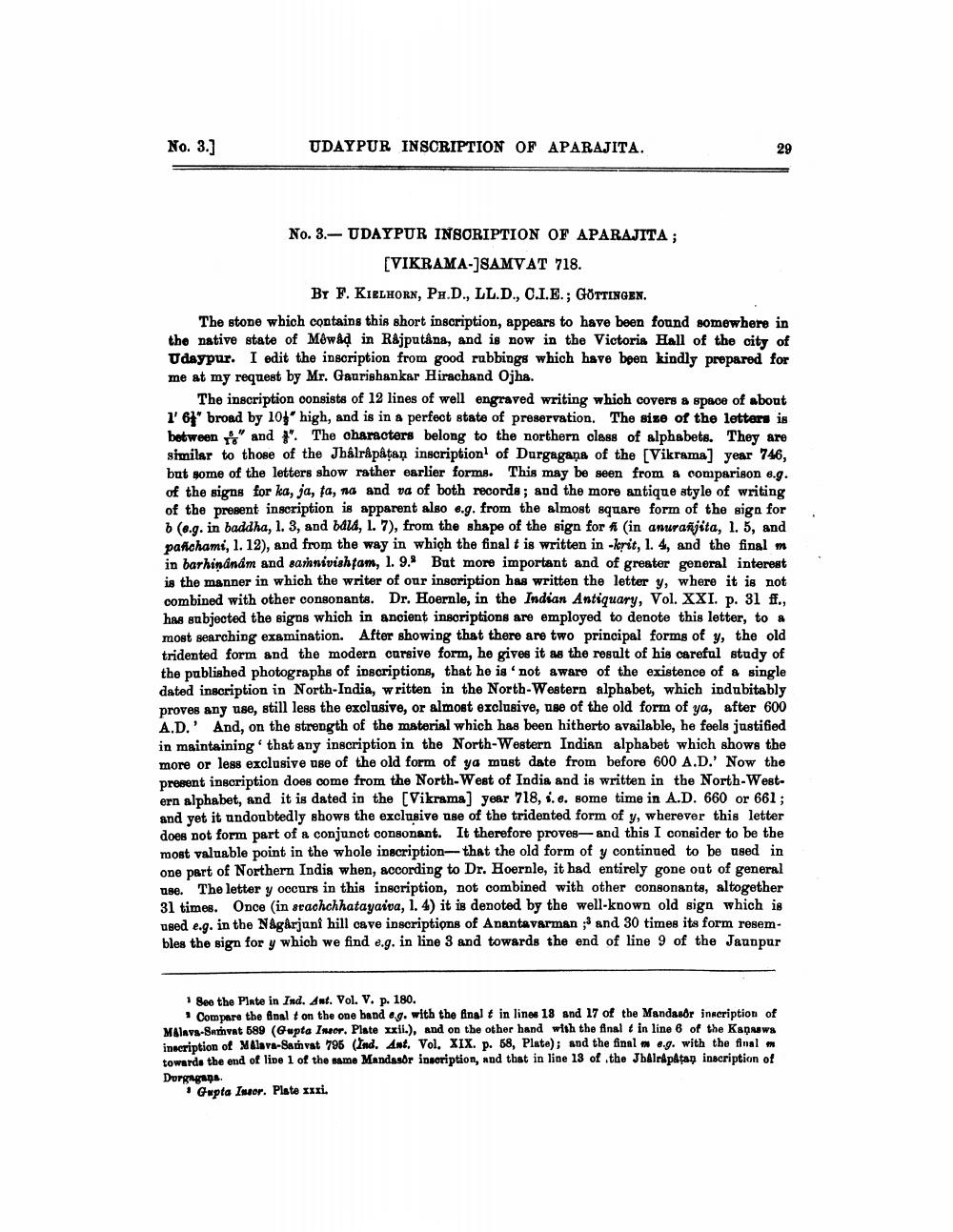________________
No. 3.]
UDAYPUR INSCRIPTION OF APARAJITA.
No. 3.- UDAYPUR INSORIPTION OF APARAJITA ;
[VIKRAMA-]SAMVAT 718.
BY F. KIELHORN, PH.D., LL.D., C.I.E.; GÖTTINGEN. The stone which contains this short inscription, appears to have been found somewhere in the native state of Mêwad in Rajputâna, and is now in the Victoria Hall of the city of Udaypur. I edit the inscription from good rubbings which have been kindly prepared for me at my request by Mr. Gaurishankar Hirachand Ojha.
The inscription consists of 12 lines of well engraved writing which covers a space of about 1' 6" broad by 10% high, and is in a perfect state of preservation. The size of the letters is between 1" and " The characters belong to the northern class of alphabets. They are similar to those of the Jbálråpåtan inscription of Durgagana of the Vikrama] year 746, but some of the letters show rather earlier forms. This may be seen from a comparison e.g. of the signs for ka, ja, ta, na and va of both records; and the more antique style of writing of the present inscription is apparent also e.g. from the almost square form of the sign for 6 (0.g. in baddha, 1. 3, and bala, 1. 7), from the shape of the sign for fi (in anurafijita, 1. 5, and pafichami, 1. 12), and from the way in which the final t is written in -krit, 1. 4, and the final m in barhinanám and sathnivishtam, 1. 9. But more important and of greater general interest is the manner in which the writer of our inscription has written the letter y, where it is not combined with other consonants. Dr. Hoernle, in the Indian Antiquary, Vol. XXI. p. 31 ff., has subjected the signs which in ancient inscriptions are employed to denote this letter, to a most searching examination. After showing that there are two principal forms of y, the old tridented form and the modern carsive form, he gives it as the result of his careful study of the published photographs of inscriptions, that he is not aware of the existence of a single dated inscription in North-India, written in the North-Western alphabet, which indubitably proves any use, still less the exclusive, or almost exclusive, use of the old form of ya, after 600 A.D.' And, on the strength of the material which has been hitherto available, he feels justified in maintaining that any inscription in the North-Western Indian alphabet which shows the more or less exclusive use of the old form of ya must date from before 600 A.D.' Now the present inscription does come from the North-West of India and is written in the North-Western alphabet, and it is dated in the (Vikrama] year 718, 1. e. some time in A.D. 660 or 661; and yet it undoubtedly shows the exclusive use of the tridented form of y, wherever this letter does not form part of a conjunct consonant. It therefore proves- and this I consider to be the most valuable point in the whole inscription- that the old form of y continued to be used in one part of Northern India when, according to Dr. Hoernle, it had entirely gone out of general 180. The letter y occurs in this inscription, not combined with other consonante, altogether 31 times. Once (in srachchhatayaiva, 1. 4) it is denoted by the well-known old sign which is used e.g. in the Nagarjuni hill cave inscriptions of Anantavarman ;s and 30 times its form resembles the sign for y which we find e.g. in line 3 and towards the end of line 9 of the Jaunpur
1 See the Plate in Ind. Ant. Vol. V. p. 180.
Compare the Analt on the one bondag, with the final t in lines 18 and 17 of the Mandasör inscription of MAlava-Nurhvat 589 (Gupta Incor. Plate xxii.), And on the other hand with the final in line 6 of the Kapaswa inscription of MAlava-Samvat 795 (Ind. Ant. Vol. XIX. p. 58, Plate); and the finale.g. with the finalm towards the end of line 1 of the same Mandasor insoription, and that in line 13 of the Jhalrapatan inscription of Durga
• Gupta Insor. Plate Ixi.




